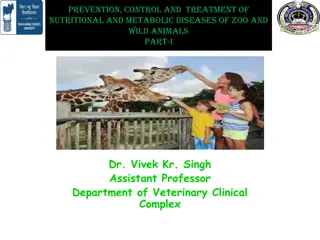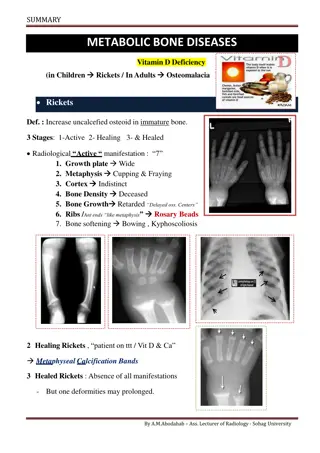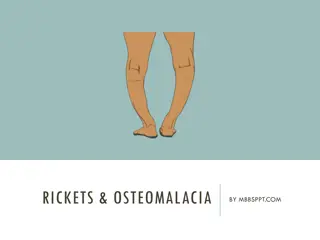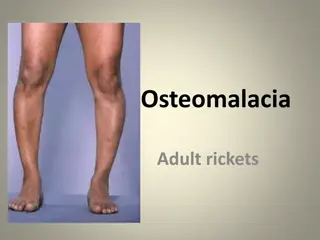Osteomalacia
Osteomalacia is a condition characterized by weakened bones due to problems in bone formation or the bone-building process. Learn about the symptoms, causes, diagnosis, and treatment of this condition to enhance your knowledge.
Download Presentation

Please find below an Image/Link to download the presentation.
The content on the website is provided AS IS for your information and personal use only. It may not be sold, licensed, or shared on other websites without obtaining consent from the author.If you encounter any issues during the download, it is possible that the publisher has removed the file from their server.
You are allowed to download the files provided on this website for personal or commercial use, subject to the condition that they are used lawfully. All files are the property of their respective owners.
The content on the website is provided AS IS for your information and personal use only. It may not be sold, licensed, or shared on other websites without obtaining consent from the author.
E N D
Presentation Transcript
StudyMafia.Org Osteomalacia Submitted To: Studymafia.org Studymafia.org Submitted By:
Table Contents Definition Introduction Symptoms of Osteomalacia Causes of Osteomalacia Diagnosis of Osteomalacia Treatment of Osteomalacia Osteomalacia Risk Factors Complications of Osteomalacia Conclusion 2
Definition Osteomalacia is a weakening of the bones. Problems with bone formation or the bone- building process causes osteomalacia. This condition isn t the same as osteoporosis. Osteoporosis is a weakening of living bone that s already formed and being remodeled. 3
Symptoms of Osteomalacia The most common is bones that fracture easily. Another is muscle weakness. This happens because of problems in the areas where muscle attaches to bone. A person with osteomalacia may have a hard time walking or may develop a waddling gait. Bone pain, especially in your hips, is also a common symptom. 4
Symptoms of Osteomalacia A dull, aching pain can spread from your hips to the following places: Lower back Pelvis Legs Ribs If you also have very low levels of calcium in your blood, you may have: Irregular heart rhythms Numbness around your mouth Numbness in your arms and legs Spasms in your hands and feet 5
Causes of Osteomalacia A lack of vitamin D is the most common cause of osteomalacia. Vitamin D is an important nutrient that helps you absorb calcium in your stomach. Vitamin D also helps maintain calcium and phosphate levels to help your bones form properly. It s made within the skin from exposure to ultraviolet (UV) rays in sunlight. It can also be absorbed from foods like dairy products and fish. You may also have a problem absorbing vitamin D or breaking down food to release it if you ve had surgery to remove parts of your stomach or small intestine. 6
Causes of Osteomalacia A vitamin D deficiency can result from: a problem with your diet a lack of sun exposure an issue with your intestines Certain conditions can interfere with the absorption of Vitamin D: Celiac disease can damage the lining of your intestines and prevent the absorption of key nutrients like vitamin D. Certain types of cancer can interfere with vitamin D processing. Kidney and liver disorders can affect the metabolism of vitamin D. 7
Diagnosis of Osteomalacia Your healthcare provider will do a blood test to diagnose the condition. If it shows any of the following, you may have osteomalacia or another bone disorder: Low levels of vitamin D Low levels of calcium Low levels of phosphorus Your healthcare provider may also test you for alkaline phosphatase isoenzymes. High levels indicate osteomalacia. 8
Diagnosis of Osteomalacia Another blood test can check your levels of parathyroid hormone. High levels of this hormone suggest insufficient vitamin D and other related problems. X-rays and other imaging tests can show small cracks in your bones. These cracks are called Looser s transformation zones. Fractures can begin in these zones even with small injuries. 9
Treatments for Osteomalacia You may only need to take oral supplements of vitamin D, calcium, or phosphate. Shop for vitamin D and calcium supplements online. This may be the first line of treatment if you have absorption problems due to intestinal injury or surgery, or if you have a diet low in key nutrients. In rare cases, you can take vitamin D as an injection through your skin or intravenously through a vein in your arm. You may need to spend some time outdoors in sunlight so your body can make enough vitamin D in your skin. 10
Complications of Osteomalacia If you don t treat the cause of your osteomalacia, there are complications. Adults can fracture bones easily such as rib, leg, and spine bones. Also, in children, osteomalacia and rickets often occur together, which can lead to bowing of the legs or premature tooth loss. Symptoms can return if not enough vitamin D is available. They ll also return if you stop taking supplements or if you don t address underlying conditions like kidney failure. 12
Conclusion When a person has osteomalacia, their newly formed bones do not mineralize, or harden, as they should. Without their hard outer layer, bones are soft and sensitive to the touch. Along with the pain and discomfort that this causes, osteomalacia increases the risk of bone fractures. Therefore, it is more likely that a person will develop deformed bones. 13
REFERENCES Google.com Wikipedia.org Studymafia.org Slidespanda.com
THANKS THANKS TO TO STUDYMAFIA STUDYMAFIA.ORG .ORG










